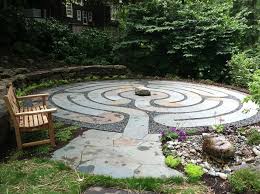About one week ago, while walking a labyrinth with a group of strangers, I was reminded that the spiritual life is not a linear path.
I must confess, this reminder was met with pretty intense frustration.
For those of you who have never had the opportunity to walk a labyrinth, imagine it as an outdoor or indoor design that looks something like the images below.
About 25 years ago in the United States it might have been quite difficult to locate a labyrinth in your nearby community.
However, nowadays labyrinths can be found in abundance in both more traditionally "spiritual" spaces like a church or a spiritual retreat center, but also in purely secular places like hospitals, public parks, and even prisons.
This growth in interest and construction of labyrinths in the United States has led some people to name it a "Labyrinth Renaissance" because labyrinths are of course not a new phenomenon as they date back thousands of years.
Traditionally, labyrinths have been used as spiritual tools.
For example, during Medieval times in Europe, an individual who wished to make a religious pilgrimage to the Middle East but was unable to, might use a labyrinth that was built into the floor of a cathedral as a metaphor for the actual religious pilgrimage there were unable to make.
Nowadays, many consider the act of walking a labyrinth to be another form of contemplative practice that may feel like prayer and/or meditation.
My first experience walking a labyrinth was about ten years ago at Kripalu Center for Yoga and Health in the Berkshires when I was 30 years-old.
Since then, I have gone into some of the literature about labyrinths to understand its purpose and possibility for my spiritual life.
For example, Dr. Lauren Artress who wrote the 1995 book Walking A Sacred Path: Rediscovering the Labyrinth as a Spiritual Tool, wrote this about the potential spiritual (and I would argue psychological) usefulness of a labyrinth:
The winding path of the labyrinth offers a blueprint for the psyche to meet the soul.
This is a bold statement to be sure, and like all spiritual practices and spiritual moments in my experience, the psyche does not necessarily meet the soul every single time.
Having said that, one week ago for me, it did, and in a moment of clarity while slowly winding back and forth between the "circuits" (that's what they are called) or meandering paths, the confusion and obstacles that I had been experiencing in multiple areas of my life since the winter time, came into focus.
Now, I am not saying that this clarity or insight was pleasant, it wasn't.
As I said already, I was frustrated, but the thing is, it felt like productive frustration if that makes any sense, and according to Dr. Artress, that is what a labyrinth is designed to do.
She writes:
The metaphors within a labyrinth are endless because they are shaped by our creative imaginations...Completion, competition, emptying, turning our back on the center, distrusting our judgment- whatever our psyches need to deal with becomes the spiritual lessons of the labyrinth....
As soon as you get settled into the labyrinth walk and get your bearings, one or more metaphors may spark within...The genius of this tool is that it reflects back to the seeker whatever he or she needs to discover from a new level of awareness.
On this day, my "new level of awareness" born of labyrinth as metaphor, was that my spiritual life--which is to say the sum and the parts of my life as a whole--is not, and will not be, linear.
Ugh!
Two forward, one back. Two back, three forward. So inefficient for this Type A Personality!
But that is how the laybrinth paths wind their way to the center of the circle before you walk your way back out in the same fashion (again, two forward, one back, two back, three forward), until you find yourself at exactly the same physical place you started from, but internally transformed.
So true, yet simultaneously so unsatisfying for this particular human who wants immediate gratification and struggles greatly with impatience.
Ironically, or serendipitously (you pick), on the same day I walked the labyrinth and was confronted with that bolt to truth about the non-linear life, I encountered this book by 20th century Dutch monastic, writer, professor, and theologian Henri Nouwen,
who wrote the well-known book: The Inner Voice of Love: A Journey Through Anguish to Freedom which was described as his "secret journal' written in the most difficult period of his life."
In this physically slight but spiritual dense book, SJ Nouwen wrote a chapter called: Keep Returning to the Road to Freedom, and it includes the following passage:
When suddenly you seem to lose all you thought you had gained, do not despair. Your healing is not a straight line. You must expect setbacks and regressions. Don't say to yourself, 'All is lost. I have to start all over again.' This is not true. What you have gained, you have gained...
It is important not to dwell on the small moments when you feel pulled away from your progress. Try to return home, to the solid place within you, immediately. Otherwise, these moments start connecting with similar moments, and together they become powerful enough to pull you far way from the road. Try to remain alert to seemingly innocuous distractions. It is easier to return to the road when you are on the shoulder than when you are pulled all the way into a nearby swamp.
Okay, so truth be told, as of late, I may have actually landed in the swamp, but nonetheless, this time I do think I have also made it back to "the road of freedom."
Thank goodness.
I hope you too can find your own metaphors, labyrinths or otherwise, that can help you remind yourself as well that the spiritual life is not a straight line.
May it be so.






No comments:
Post a Comment